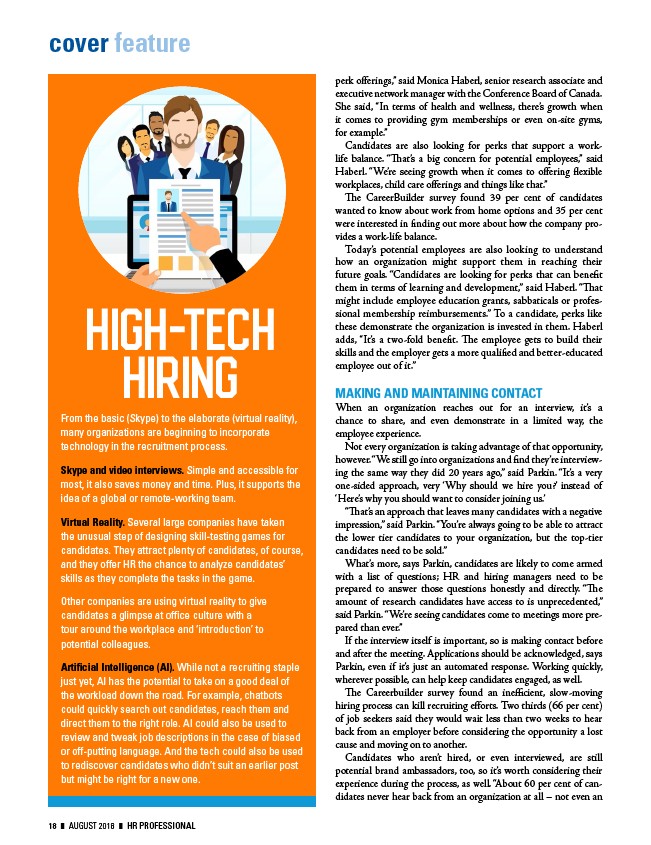
perk offerings,” said Monica Haberl, senior research associate and
executive network manager with the Conference Board of Canada.
She said, “In terms of health and wellness, there’s growth when
it comes to providing gym memberships or even on-site gyms,
for example.”
Candidates are also looking for perks that support a work-life
balance. “That’s a big concern for potential employees,” said
Haberl. “We’re seeing growth when it comes to offering flexible
workplaces, child care offerings and things like that.”
The CareerBuilder survey found 39 per cent of candidates
wanted to know about work from home options and 35 per cent
were interested in finding out more about how the company pro-vides
a work-life balance.
Today’s potential employees are also looking to understand
how an organization might support them in reaching their
future goals. “Candidates are looking for perks that can benefit
them in terms of learning and development,” said Haberl. “That
might include employee education grants, sabbaticals or profes-sional
membership reimbursements.” To a candidate, perks like
these demonstrate the organization is invested in them. Haberl
adds, “It’s a two-fold benefit. The employee gets to build their
skills and the employer gets a more qualified and better-educated
employee out of it.”
MAKING AND MAINTAINING CONTACT
When an organization reaches out for an interview, it’s a
chance to share, and even demonstrate in a limited way, the
employee experience.
Not every organization is taking advantage of that opportunity,
however. “We still go into organizations and find they’re interview-ing
the same way they did 20 years ago,” said Parkin. “It’s a very
one-sided approach, very ‘Why should we hire you?’ instead of
‘Here’s why you should want to consider joining us.’
“That’s an approach that leaves many candidates with a negative
impression,” said Parkin. “You’re always going to be able to attract
the lower tier candidates to your organization, but the top-tier
candidates need to be sold.”
What’s more, says Parkin, candidates are likely to come armed
with a list of questions; HR and hiring managers need to be
prepared to answer those questions honestly and directly. “The
amount of research candidates have access to is unprecedented,”
said Parkin. “We’re seeing candidates come to meetings more pre-pared
than ever.”
If the interview itself is important, so is making contact before
and after the meeting. Applications should be acknowledged, says
Parkin, even if it’s just an automated response. Working quickly,
wherever possible, can help keep candidates engaged, as well.
The Careerbuilder survey found an inefficient, slow-moving
hiring process can kill recruiting efforts. Two thirds (66 per cent)
of job seekers said they would wait less than two weeks to hear
back from an employer before considering the opportunity a lost
cause and moving on to another.
Candidates who aren’t hired, or even interviewed, are still
potential brand ambassadors, too, so it’s worth considering their
experience during the process, as well. “About 60 per cent of can-didates
never hear back from an organization at all – not even an
cover feature
HIGH-TECH
HIRING
From the basic (Skype) to the elaborate (virtual reality),
many organizations are beginning to incorporate
technology in the recruitment process.
Skype and video interviews. Simple and accessible for
most, it also saves money and time. Plus, it supports the
idea of a global or remote-working team.
Virtual Reality. Several large companies have taken
the unusual step of designing skill-testing games for
candidates. They attract plenty of candidates, of course,
and they offer HR the chance to analyze candidates’
skills as they complete the tasks in the game.
Other companies are using virtual reality to give
candidates a glimpse at office culture with a
tour around the workplace and ‘introduction’ to
potential colleagues.
Artificial Intelligence (AI). While not a recruiting staple
just yet, AI has the potential to take on a good deal of
the workload down the road. For example, chatbots
could quickly search out candidates, reach them and
direct them to the right role. AI could also be used to
review and tweak job descriptions in the case of biased
or off-putting language. And the tech could also be used
to rediscover candidates who didn’t suit an earlier post
but might be right for a new one.
18 ❚ AUGUST 2018 ❚ HR PROFESSIONAL